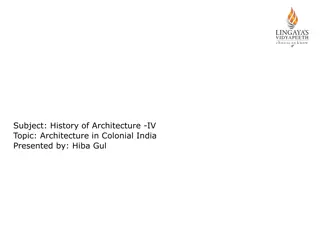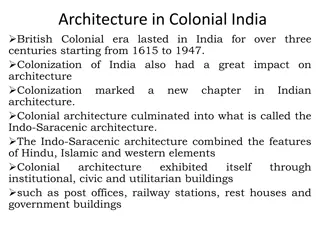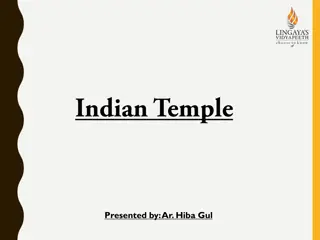Colonial India's Architectural Marvels: Senate House and Victoria Memorial Hall
Discover the architectural beauty of Colonial India through two iconic monuments - Senate House at the University of Madras and Victoria Memorial Hall in Calcutta. Designed by renowned architects of the 19th century, these structures showcase a blend of Indo-Saracenic and classical styles, highlighting the rich history and cultural heritage of the era.
Download Presentation

Please find below an Image/Link to download the presentation.
The content on the website is provided AS IS for your information and personal use only. It may not be sold, licensed, or shared on other websites without obtaining consent from the author. Download presentation by click this link. If you encounter any issues during the download, it is possible that the publisher has removed the file from their server.
E N D
Presentation Transcript
Subject: History of Architecture -IV Topic: Architecture in Colonial India Presented by: Hiba Gul
Senate Senate House House:: University University of of Madras Madras It is one of the finest monuments in Chennai and a living example which shows the remarkable architectural skills of the famous architect of 19th century, Robert Fellowes Chisholm. The structure is a live example of the Indo-Saracenic style with a harmonious blend of Byzantine architectural features. Architecture Architecture The Senate house has a central hall with corridors on the ground floor. The corridors stand on six massive pillars standing on either side. Also the four sky touching towers standing at each of the corners of the building gives it a dazzling look. The six porches, two on the eastern and western sides of the building and one each on the northern and southern side of the building further lend the structure a vintage look. There also are three segmental arch openings in each porch in the east, west and south of the porch. The roof is made of brick shell with lime mortar.
Victoria Memorial Hall at Calcutta Victoria Memorial Hall at Calcutta Victoria Memorial Hall is one of the most magnificent monuments of not only the city of Calcutta but of our entire country. VMH was envisaged by Lord Curzon, the Viceroy of British India, as a memorial to the deceased Queen Victoria. The memorial was to be designed with a museum housed within its realms. The memorial with the museum would act as a standing record of our wonderful history This was to be a historical museum where people could see before them pictures and statues of men who played a prominent part in the history of this country and develop a pride in their past after Queen death in January 1901 a great meeting was convened- to raise fund to construct memorial.
Total cost of construction of this monument amounting to one crore, five lakhs of rupees, was entirely derived from their voluntary subscriptions. King George V, the then Prince of Wales, laid the foundation stone on January 4, 1906 and it was formally opened to the public in 1921. Architecture Architecture Curzon entrusted architect William Emerson who already had to his glory the famous architectural buildings like the Crawford market in Bombay and All Saints Cathedral in Allahabad Curzon insisted on classical style and he insisted Emerson to submit designs in the Italian renaissance style Vincent Jerome Esch Supervising architect
The Victoria Memorial is topped by an enormous (16' high, 3-tonne) bronze Angel of Victory, which is capable of revolving The design is in the Indo-Saracenic revivalist style which uses a mixture of British and Mughal elements with Venetian, Egyptian, Deccani and Islamic architectural influences The building is 338 feet (103 m) by 228 feet (69 m) and rises to a height of 184 feet (56 m). It is constructed of white Makrana marble The gardens of the Victoria Memorial were designed by Lord Redesdale and David Prain.
Sir Edwin Landseer Lutyens Sir Edwin Landseer Lutyens The architectural historian Gavin Stamp described him as "surely the greatest British architect of the twentieth (or of any other) century An English architect known for imaginatively adapting traditional architectural styles to the requirements of his era. He designed many English country houses, war memorials and public buildings Lutyens played an instrumental role in designing and building New Delhi, which would later on serve as the seat of the Government of India. In recognition of his contribution, New Delhi is also known as "Lutyens' Delhi". In collaboration with Sir Herbert Baker, he was also the main architect of several monuments in New Delhi such as the India Gate; he also designed Viceroy's House, which is now known as the Rashtrapati Bhavan
Lutyens invented his own new order of classical architecture, which has become known as the Delhi Order and was used by him for several designs in England, such as Campion Hall, Oxford. Unlike the more traditional British architects who came before him, he was both inspired by and incorporated various features from the local and traditional Indian architecture something most clearly seen in the great drum-mounted Buddhist dome of Viceroy's House, now Rashtrapati Bhavan. This palatial building, containing 340 rooms, is built on an area of some 330 acres (1.3 km2) and incorporates a private garden also designed by Lutyens. The building was designed as the official residence of the Viceroy of India and is now the official residence of the President of India
The new city contains both the Parliament buildings and government offices (many designed by Herbert Baker) and was built distinctively of the local red sandstone using the traditional Mughal style. Other buildings in Delhi that Lutyens designed include Baroda House, Bikaner House, Hyderabad House, and Patiala House.
















































